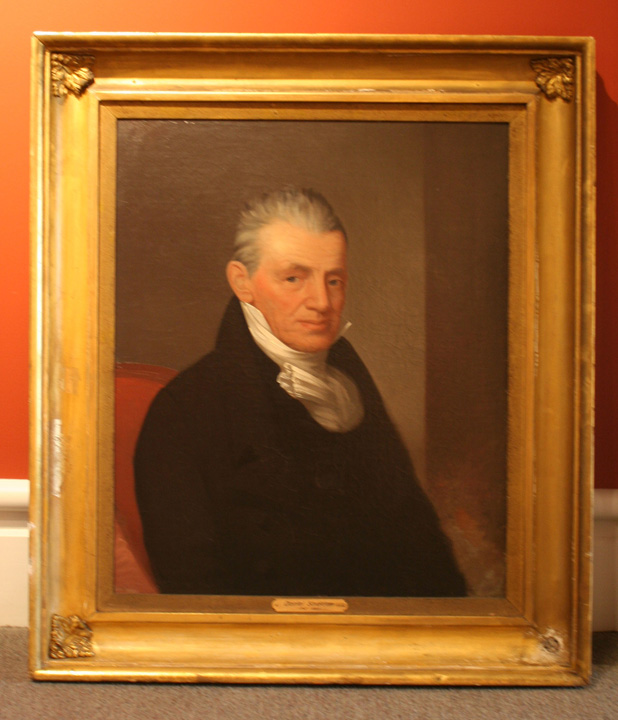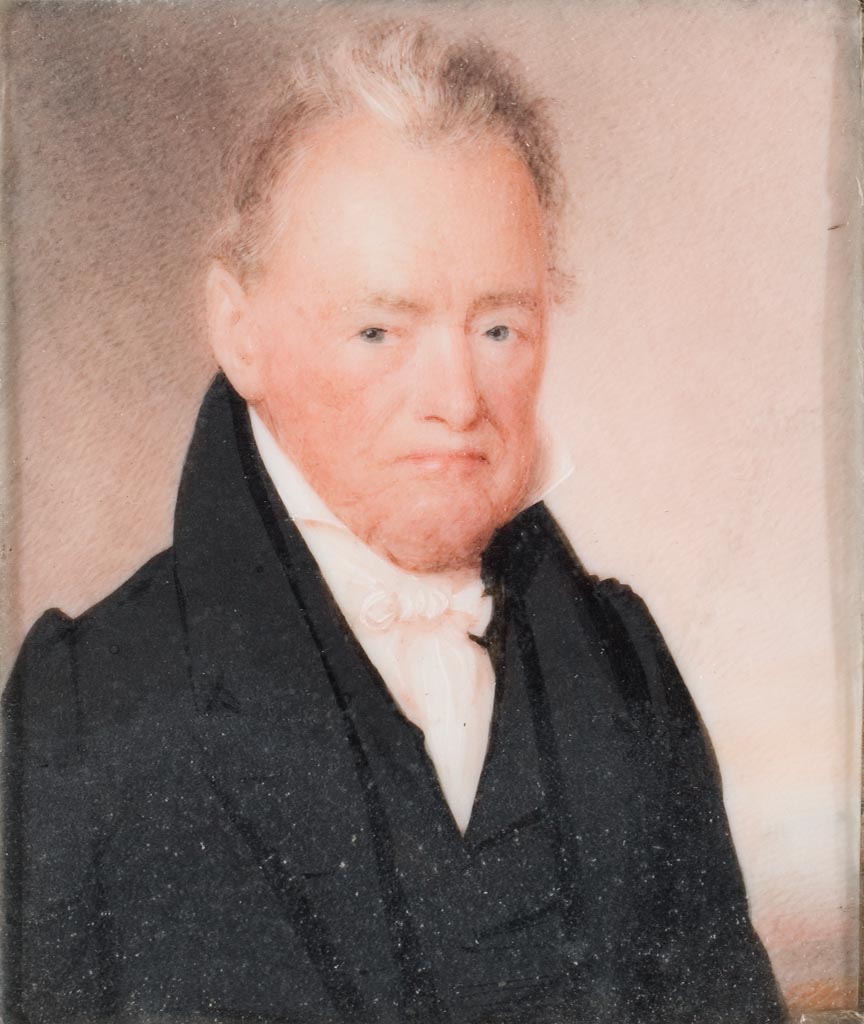This month the Historical Society was happy to welcome Dr. Daniel Sheldon (1750-1840) back to Litchfield. Confused? I can understand why. Dr. Sheldon, himself, did not return to Litchfield but a portrait of the well respected doctor did.

Dr. Daniel Sheldon, Artist Unknown, ca. 1810. Purchased by the Historical Society from the Hartford Medical Society Library
The painting was being deaccessioned by the Hartford Medical Society Library in Farmington, CT. The Library is operated by the University of Connecticut and located at their Farmington campus. The Historical Society purchased the painting from the Library and both parties were thrilled to return Dr. Sheldon to Litchfield.
Dr. Sheldon operated a successful medical practice in Litchfield for over fifty years. He was born in Hartford, CT on October 19, 1750. He received his early education at the Hartford Grammer School which supported a reputation as one of the best literary institutions in New England. Afterwards, he apprenticed himself to Dr. Seth Bird of Litchfield, who at the time was one of the most prominent medical men in the state. At the age of 21, Sheldon opened his own practice in Woodbury. Shortly afterwards he married Charlotte Judson in 1777 and they had two children together Charlotte Sheldon and Daniel Sheldon. He moved to Litchfield in 1784, when the current physician of the town Dr. Lemuel Hopkins moved to Hartford creating an opportunity for a new doctor to take his place.
His practice grew, attained respectability and his reputation far exceeded the boundaries of Litchfield. His wife Charlotte died shortly after his move to Litchfield and Sheldon then married Huldah Stone. The couple had four children together Lucy, Frederick, Henry and William.
Dr. Sheldon is described in the American Medical Biography: or, Memoirs of Eminent Physicians by Stephen West Williams in 1845,
Dr. Sheldon was endowed by nature with a vigorous and well balanced mind; he was quick to discover and ready to apply all his knowledge in the practice of his profession. He had the tact which led him at once to the indication of disease, and boldness in his prescriptions which only comes properly from a thorough knowledge of the case. He was also a learned man, fond of books, and a thorough, diligent student. He had a faculty of gleaning from authors whatever was valuable in their works by a hasty perusal of their pages. His memory was retentive, he profited greatly by his own experience, and was enabled to have analogies by which that experience was of great value to him. In the treatment of pulmonary consumption he had great and desired celebrity. Many persons affected with symptoms of that disease, flocked to him from a great distance, and his success sustained his reputation, till from age and infirmity he ceased to practice his profession. The writer met him repeatedly in such cases. There was no quackery about his practice, but plain, open, common sense views of what changes might be wrought by perseverance and suitable remedies . . .

Dr. Daniel Sheldon by Anson Dickinson, 1831, Courtesy of the Litchfield Historical Society
His remedies were simple, but effective. Substantial diet, narcotic and tonic remedies, and riding on horseback, which he considered superior to all other means of restoration, and quite superior to all other modes of exercise. He was a successful physician in this and other chronic cases, and his counsel was sought by many respectable individuals near and remote. It was my good fortune to meet him occasionally, and at our last interview he spent some days with me at my residence. His conversation was most instructive and his kindness and courtesy made a deep impression on my feelings.
In addition to his medical practice, Sheldon helped to found the State Medical Society in Connecticut. He was also given an honorary Doctoral degree of Medicine by Yale College. Throughout most of his life he was also addicted to opium. The daily drug use began after an abscess in his lungs burst and necessitated the administration of a pain reliever. Opium was a common drug in the 18th century and used by many people to medicate pain and discomfort. Late in his life, Sheldon broke his addiction to opium by slowly lessening his use of the drug. He died on April 10, 1840 at the age of 89.
Sheldon lived on North Street and his home is still standing today. He sent all of his children, sons as well as daughters to the Litchfield Female Academy. His son’s Daniel and William also attended the Litchfield Law School. The Sheldon’s also boarded students who traveled to Litchfield to attend one of the schools. His daugher Lucy Sheldon Beach (wife of Dr. Theron Beach) continued to live in the Sheldon home until her death in 1889.
The Sheldon family papers are now part of the Helga J. Ingraham Memorial Library at the Litchfield Historical Society. They have been cataloged in Archon and the finding aid available online by visiting the museum’s Web site and clicking on the button “Archon: Finding Aids.” The direct link to the Sheldon family papers is: http://www.litchfieldhistoricalsociety.org/archon/index.php?p=collections/controlcard&id=652
Welcome home Dr. Sheldon!